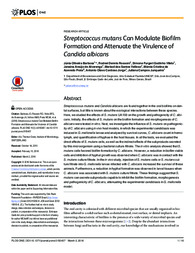Streptococcus mutans can modulate biofilm formation and attenuate the virulence of Candida albicans.
Streptococcus mutans can modulate biofilm formation and attenuate the virulence of Candida albicans.
Author(s): BARBOSA, J. O.; ROSSONI, R. D.; VILELA, S. F. G.; ALVARENGA, J. A. de; VELLOSO, M. dos S.; PRATA, M. C. de A.; JORGE, A. O. C.; JUNQUEIRA, J. C.
Summary: Abstract Streptococcus mutans and Candida albicans are found together in the oral biofilms on dental surfaces, but little is known about the ecological interactions between these species. Here, we studied the effects of S. mutans UA159 on the growth and pathogencity of C. albicans. Initially, the effects of S. mutans on the biofilm formation and morphogenesis of C. albicans were tested in vitro. Next, we investigate the influence of S. mutans on pathogenicity of C. albicans using in vivo host models, in which the experimental candidiasis was induced in G. mellonella larvae and analyzed by survival curves, C. albicans count in hemolymph, and quantification of hyphae in the host tissues. In all the tests, we evaluated the direct effects of S. mutans cells, as well as the indirect effects of the subproducts secreted by this microorganism using a bacterial culture filtrate. The in vitro analysis showed that S. mutans cells favored biofilm formation by C. albicans. However, a reduction in biofilm viable cells and inhibition of hyphal growth was observed when C. albicans was in contact with the S. mutans culture filtrate. In the in vivo study, injection of S. mutans cells or S. mutans culture filtrate into G. mellonella larvae infected with C. albicans increased the survival of these animals. Furthermore, a reduction in hyphal formation was observed in larval tissues when C. albicans was associated with S. mutans culture filtrate. These findings suggest that S. mutans can secrete subproducts capable to inhibit the biofilm formation, morphogenesis and pathogenicity of C. albicans, attenuating the experimental candidiasis in G. mellonella model.
Publication year: 2016
Types of publication: Journal article
Unit: Embrapa Dairy Cattle
Keywords: Biofilms, Biosupression, Patology, microbiology
Observation
Some of Embrapa's publications are published as ePub files. To read them, use or download one of the following free software options to your computer or mobile device. Android: Google Play Books; IOS: iBooks; Windows and Linux: Calibre.
Access other publications
Access the Agricultural Research Database (BDPA) to consult Embrapa's full library collection and records.
Visit Embrapa Bookstore to purchase books and other publications sold by Embrapa.

